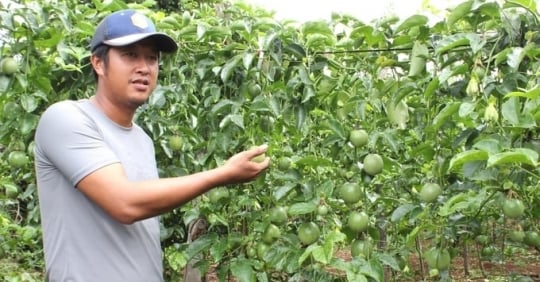(VAN) Gia Lai, which has previously been regarded as the capital of passion fruit, is slowly dying out despite overwhelming initial hopes and expectations.
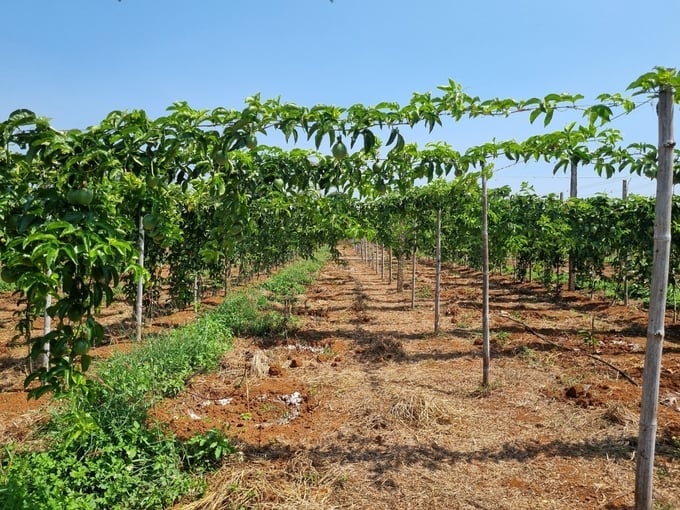
Over a year ago, the passion fruit craze swept across the province of Gia Lai. Photo: Tuan Anh.
The passion fruit farming craze, accompanied by the emergence of large-scale processing plants, propelled Gia Lai to be known as the capital of a multimillion-dollar industry. However, that dream quickly dissipated due to an underlying price “crash” wave. At present, passion fruit has fallen out of popularity within the province.
A fleeting moment of glory
Just over a year ago, vibrant passion fruit farms, adorned with lush greenery and heavy-laden branches, dotted the landscapes along the roads of Gia Lai province. Local residents referred to passion fruit as a “miraculous” crop, with promises of substantial incomes that allow them to build houses and buy cars after only several harvests. Passion fruit even surpassed other traditionally dominant crops in the province such as coffee and pepper, which had previously established the Central Highlands’ agricultural brand.
The expectations associated with passion fruit led the leadership of Gia Lai’s agricultural sector to set a goal of expanding the production area to over 25,000 hectares by 2025.
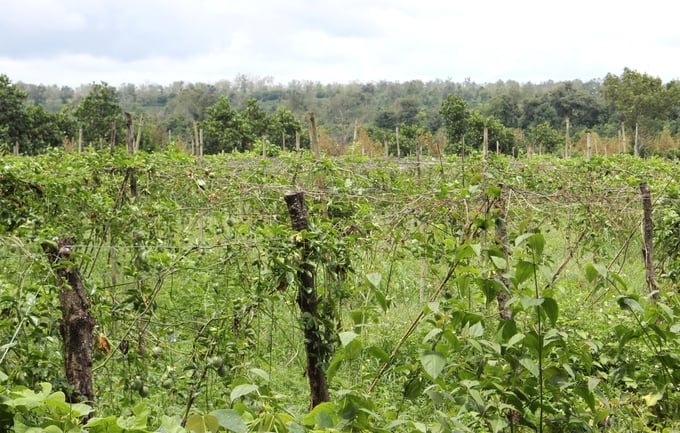
Passion fruit’s popularity dwindled as farmers abandon their farms. Photo: Tuan Anh.
However, the price of passion fruit plummeted from 17,000 to 3,000 Vietnamese dong per kilogram for passion fruit pulp over the span of several months in mid-2023, plunging the multimillion-dollar industry into disarray and leaving numerous local farming households to struggle.
The previously bountiful passion fruit farms have been gradually replaced by replanted coffee farms, or fields of corn, peanuts, and watermelons, among others. Discussions surrounding passion fruit has all but vanished from the local community, save for the occasional resigned nods of recognition.
Welcoming us into his still-unpainted home, Le Kim Long, a resident of Ia Lok hamlet, Ia Mo Nong commune, Chu Pah district, reflected on the wasted potentials of passion fruit. His family became heavily invested into this crop after beginning cultivation in 2018.
Having been closely associated with passion fruit with considerable success, Long’s first achievement came in early 2023 when passion fruit prices skyrocketed to nearly 20,000 Vietnamese dong per kilogram. With 1.7 hectares of passion fruit farming area, Long’s profits exceeded 600 million Vietnamese dong per harvest. “The success motivated us to expand further, and that’s when the passion fruit ‘collapse’ began,” Long shared with regret.
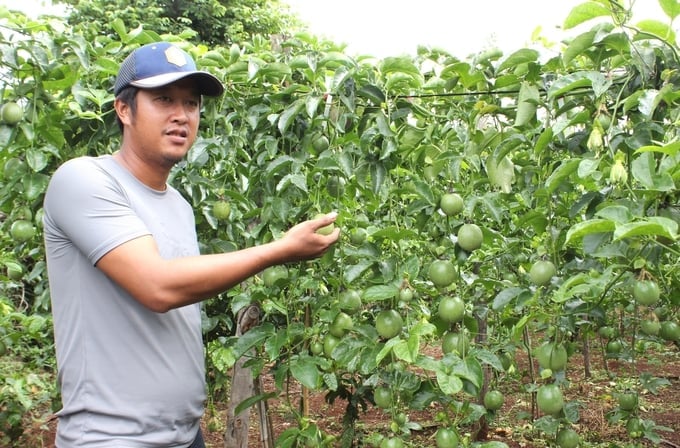
Le Kim Long, a resident of Ia Lok hamlet, Ia Mo Nong commune, Chu Pah district, previously enjoyed relative success with his passion fruit farm. Photo: Tuan Anh.
According to Long’s analysis, the “collapse” of the passion fruit market resulted from the uncontrolled production by local farmers. This led to a decline in the quality of passion fruit seedlings. Additionally, harsh weather conditions, marked by prolonged rains, further weakened the passion fruit plants. Most critically, prices plummeted precisely when the passion fruit was facing numerous challenges. Consequently, farmers’ confidence plunged along with their withering passion fruit farms.
Long commented on the struggle: “If prices stabilize at a lower level, we will continue cultivating our passion fruit crops, but cautiously. For now, we will plant 5 hectares of passion fruit, and adopt careful farming practices to minimize risks.”
Parting ways with Long, we traveled to Ia Grai district, previously known for housing the largest passion fruit farming area in Gia Lai province. During our last visit to hamlet 1 in Ia Hrung commune, passion fruit farms accounted for a sizeable portion of the local land area. However, this area has significantly diminished, replaced by sprouting replanted coffee farms.
Dinh Xuan Khang, a resident of hamlet 1, Ia Hrung commune, recalled that traders previously flocked to the province to purchase passion fruit. Notably, a 3-hectare passion fruit farming area would require multiple trucks to transport all the harvested fruit. During the harvest season, Khang’s family earned upwards of 10 million Vietnamese dong per day from passion fruit sales.
Khang added: “With the collapse of the passion fruit market and the rising coffee prices, local farmers no longer have the confidence to invest in passion fruit as before. They now only cultivate passion fruit alongside coffee as a way to supplement income and reduce risks. As for my family, due to our attachment to the fruit, we will plant 8 hectares in the hope that this crop will regain its former glory after a period of disillusionment.”
A hard-learned lesson for local farmers
As a journalist specializing in agriculture, I was enthusiastic to witness the passion fruit craze and the lucrative profits it once yielded. A friend of mine who is the director of a local cooperative also suggested me to invest in passion fruit farming. My friend handled the technical aspects and farm management, while I focused on securing land and networking.
“The passion fruit farming process must comply with organic standards in order to meet European export demands,” my friend’s proposal further strengthened my confidence – who is already relatively knowledgeable in the organic farming sector.
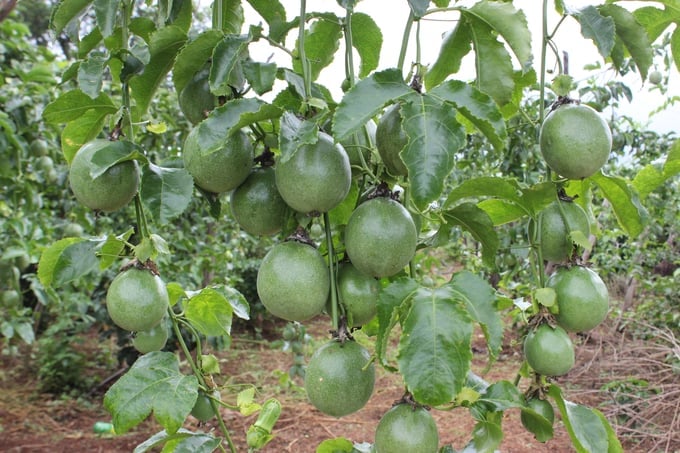
The author of this article has previously ventured into collaborative efforts to cultivate organic passion fruit and learned a hard-earned lesson. Photo: Tuan Anh.
In just under one month from the inception of the idea, a passion fruit farm spanning over 7 hectares took shape. Due to the nature of the organic farming process, I made extensive investment into every aspect of the farm, from the stakes to the steel wires binding the trellises, with the aim of maintaining uniform planting rows according to standard practices. Notably, I invested in a ground-sprinkler system to further fortify the prospects of a successful passion fruit harvest.
Confidence grew as the passion fruit farm blossomed remarkably. Within only three months, the vines covered the trellises, laden with abundant and enticing fruits. My confidence was further strengthened when a friend, the director of a company specializing in purchasing and exporting passion fruit, visited the farm and remarked, “A beautifully flourishing passion fruit farm such as this would be able to meet over 70% of the European export standards.”
However, fortune did not favor us, as persistent, heavy rains in the subsequent days significantly damaged our passion fruit farm. Once plump and glossy, the passion fruit turned into appetizing bait for various diseases such as Alternaria passiflorae and fruit rot.
From aspirations of exporting to Europe, my passion fruit farm was eventually bought by traders primarily for the pulp, with prices plummeting to 3,000 Vietnamese dong per kilogram at the time. The profits failed to cover labor costs, nearly causing my friend to give up. However, I was determined to persevere, with hopes of a more positive future.
Wake-up call for a more discerning approach to passion fruit farming
To gain deeper insights into the passion fruit craze, we turned to Le Van Thanh, Director of the Ia Mo Nong Agricultural Production – Trade – Service – Tourism Cooperative in Chu Pah district. During its prime, the Ia Mo Nong Cooperative collaborated with over 200 households to cultivate nearly 200 hectares of passion fruit. The cooperative would purchase several thousands tons of passion fruit from local farmers to supply processing plants on an yearly basis. The cooperative reached a record profit of nearly 60 billion Vietnamese dong in a single year. “At present, both the farming area and yield of passion fruit are less than one-tenth of what they were during the our prime,” Thanh shared.
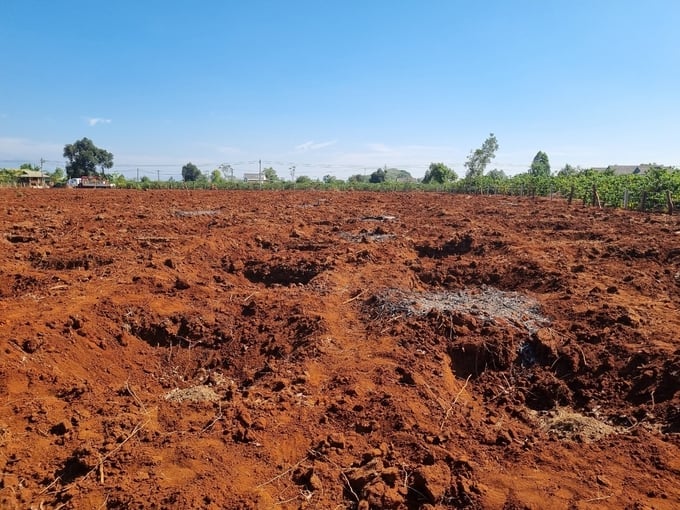
Passion fruit farms are dismantled in favor of coffee production. Photo: Tuan Anh.
According to Director Thanh, the key factor to the collapse of the passion fruit market is the inflated projections for expanding the farming area to 25,000 hectares by 2025. If these projections were to be true, there would need to be specific commitments between farmers, cooperatives, and businesses. For instance, agreements to prevent the price of passion fruit from falling below 7,000 Vietnamese dong per kilogram – the breakeven point – would be necessary to motivate farmers.
“The exaggeration regarding passion fruits was solely aimed at benefiting purchasing businesses, whereas farmers faced complete failure,” Director Thanh remarked.
Director Thanh believes that it is time for farmers to adopt a more discerning approach to passion fruit farming, drawing lessons from the financial losses incurred in rubber and pepper farming activities. The exaggeration surrounding rubber and pepper farming, once likened to “white” and “black” gold, respectively, has also contributed to considerable failures.
Agriculture News | Agri Products Price



